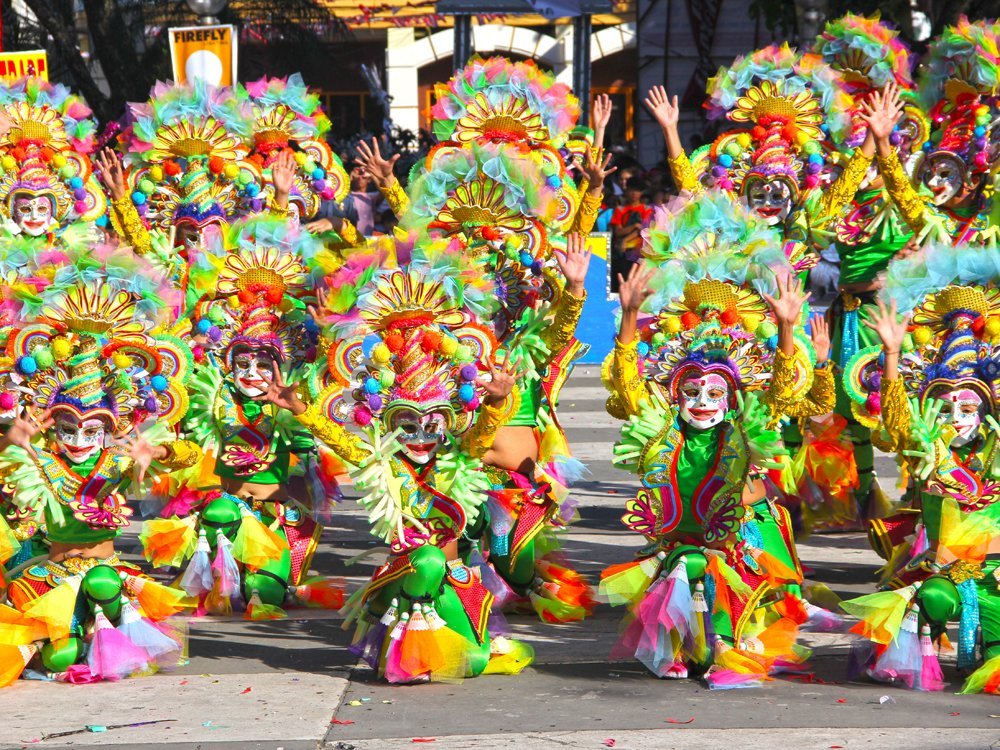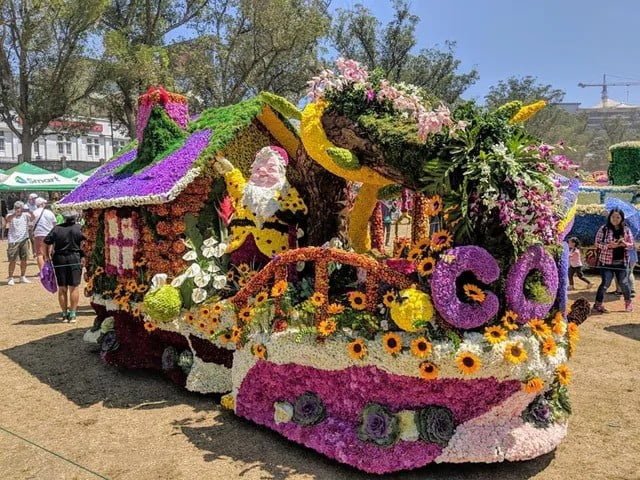Pahiyas Festival: A Vibrant Celebration of Filipino Culture and Traditions
The Pahiyas Festival, an annual celebration held in Lucban, Quezon, Philippines, is a bright and colorful event that showcases the town’s rich agricultural bounty. Every May 15th, locals participate by decorating their homes with a vibrant array of fruits, vegetables, and other agricultural products. This tradition is done in honor of San Isidro Labrador, the patron saint of farmers, as a way of thanking him for a bountiful harvest and seeking his blessings for the coming year.
The festival has its roots in ancient customs practiced by farmers to give thanks for abundant harvests. Over time, the Pahiyas Festival has evolved into a grand display of creativity and craftsmanship, with locals competing to create the most intricate and eye-catching decorations using various native materials. As a result, the town transforms into a lively and colorful canvas, drawing tourists from near and far to witness this unique tradition.
Key Takeaways
- The Pahiyas Festival is a yearly event held in Lucban, Quezon, honoring the patron saint of farmers
- It showcases the creativity of locals in decorating their homes with agricultural products
- The festival attracts numerous tourists, boosting local economy and fostering cultural appreciation
Historical Significance

Origins and Evolution
The Pahiyas Festival is a vibrant and lively event that takes place annually in the town of Lucban in the Philippines. This deeply rooted tradition has a rich history that dates back approximately five centuries. The festival’s origins can be traced back to a period when local farmers offered the early harvest to their ancestral spirits in gratitude for a bountiful yield.
Over the years, the Pahiyas Festival has evolved and been heavily influenced by the Catholic faith, leading to an intriguing blend of cultural and religious elements. As the festival’s popularity grew, the small-scale offering evolved into a grander event to honor the town’s patron saint, San Isidro Labrador, who is the patron of farmers and agriculture.
The festival’s main highlights are the colorful and intricately designed displays made of various materials such as rice, fruits, vegetables, and other local products. These displays often take the form of:
- Kiping: leaves made of rice paste, dyed with vibrant colors
- Arangya: chandeliers made of household items and agricultural products
- Bandera Española: colorful and elaborate banners inspired by Spanish flags
Catholic and Cultural Syncretism
The Pahiyas Festival perfectly showcases the interesting syncretism between the Catholic faith and local cultural practices in the Philippines. The celebration is centered around honoring San Isidro Labrador while also maintaining connections to pre-colonial traditions.
During the event, a procession is held which features a statue of the patron saint, accompanied by local farmers dressed as ancient ancestors to show respect to their cultural roots. This fascinating blend of religious and cultural elements has become a defining characteristic of the Pahiyas Festival, as it is now a significant event that attracts thousands of visitors from all over the world.
Festival Highlights
The Kiping and House Decorations
The Pahiyas Festival is best known for its vibrant and colorful kiping decorations. Kiping is a traditional Filipino leaf-shaped wafer made of rice paste, known for its brilliant colors and intricate patterns. During the festival, locals showcase their creativity by decorating their houses with these eye-catching kiping, often in elaborate displays that combine different shapes, colors, and sizes.
In addition to kiping, houses are also adorned with a variety of other materials that highlight the bountiful harvest of the region. Decorations made from vegetables, fruits, grains, and farming implements are common sights.
San Isidro Labrador Procession
The heart of the Pahiyas Festival is the San Isidro Labrador Procession. This religious event honors the patron saint of farmers, San Isidro Labrador, and typically features a parade of beautifully decorated floats, stunning flower arrangements, and local bands. The procession is both an expression of gratitude for past harvests and a request for continued blessings in the future, making it essential to the festival’s traditions.
Food and Delicacies
The Pahiyas Festival is also a celebration of Lagation, the local cuisine of the region. Foodies will be delighted by the variety of delicacies that are showcased during the festival, including:
- Pancit Habhab – a delicious noodle dish served on banana leaves
- Lucban Longganisa – a popular garlic-infused sausage native to the region
- Hardinera – a unique, locally-made meatloaf cooked in banana leaves
Apart from these, plenty of other local foods, snacks, and refreshments can be found throughout the festival.
Artistic Displays and Competitions
One of the highlights of Pahiyas Festival is the display of talent and creativity through various competitions:
- Kiping decoration contest: homeowners compete using kiping as the main component of their house decorations.
- Float competition: colorful floats adorned with harvest products, kiping, and flowers are judged on their originality and visual appeal.
- Street dance competition: locals dress in festive costumes and perform traditional dances, adding vibrance and energy to the celebrations.
These artistic displays highlight the creative spirit and sense of community that permeate the Pahiyas Festival, making it a truly unique and unforgettable experience.
Cultural and Economic Impact
Influence on Local Agriculture
The Pahiyas Festival has a significant impact on the local agriculture of the Province of Quezon. This colorful and vibrant annual event celebrates the bountiful harvest that farmers in the region enjoy. The festival serves as a thanksgiving ceremony, showcasing a wide variety of agricultural products that the locals have successfully cultivated.
During the festivities, farmers display their finest crops, fruits, vegetables, and even livestock. This celebration not only motivates the farmers but also highlights the agricultural importance of the Province of Quezon. The event allows farmers to display their produce and encourage the continuation of traditional agricultural practices.
Tourism and Economic Growth
The Pahiyas Festival has become a major tourist attraction in the Philippines, drawing thousands of tourists from both local and international destinations. The festival has a notable influence on the economy of the Province of Quezon and the country as a whole.
| Key Aspects | Benefits |
|---|---|
| Travel | Boosts local transportation |
| Accommodation | Increases demand for lodging |
| Tourist Attractions | Generates revenue from guided tours |
As a result, there is an increase in travel to the region during this time, which in turn supports economic growth in the transportation sector. Accommodation also sees significant growth, with hotels, guesthouses, and homestays enjoying increased bookings and occupancy rates.
Moreover, the Pahiyas Festival generates a considerable amount of revenue from guided tours, local attractions, and other activities that showcase the rich culture and traditions of the Province of Quezon.
In summary, the Pahiyas Festival has a significant cultural and economic impact. Its influence on local agriculture instills a sense of pride and motivation in the farmers, who showcase their bountiful harvests. Additionally, it contributes to the growth of tourism and economic sectors in the Province of Quezon.
Frequently Asked Questions
What is the significance of the Pahiyas Festival?
The Pahiyas Festival is a vibrant and colorful annual event in the Philippines that celebrates a bountiful harvest by showcasing beautifully decorated houses. The festival is a way for farmers to express gratitude to their patron saint, San Isidro Labrador, for the abundant harvest.
Where is the Pahiyas Festival originally celebrated?
The Pahiyas Festival is originally celebrated in the town of Lucban, in the province of Quezon, Philippines. The town comes alive each year with colorful decorations and festivities.
Can you describe the history behind the Pahiyas Festival?
The history of the Pahiyas Festival dates back to the early days of Spanish colonization in the Philippines. The tradition began with farmers offering a portion of their harvest to San Isidro Labrador, believing that the saint would bless them with an abundant crop. Over time, this offering turned into the spectacular display of colorful and creative decorations that we see today during the festival.
What are the traditional foods associated with the Pahiyas Festival?
A variety of local delicacies are enjoyed during the Pahiyas Festival, including kiping (rice wafers), longganisa (Filipino sausage), and pancit habhab (noodle dish). These traditional dishes are a reflection of the local culture and are an important part of the festivities.
What type of costumes are typically worn during the Pahiyas Festival?
Participants in the Pahiyas Festival often wear traditional Filipino clothing, such as the barong Tagalog for men and the baro’t saya for women. These outfits are made from indigenous materials and showcase vibrant colors and intricate details, reflecting the festive spirit of the event.
What are the key attractions and activities during the Pahiyas Festival?
During the Pahiyas Festival, key attractions and activities include the beautifully decorated houses adorned with agricultural products and colorful kiping, the street dancing competition featuring traditional Filipino dances, and various parades showcasing the local culture. In addition, visitors can enjoy the local cuisine, traditional music, and handicrafts, making the Pahiyas Festival an all-encompassing celebration of the town’s heritage and agriculture.



Pingback: Sinulog Festival: A Colorful Celebration in Cebu City
Pingback: Panagbenga Festival 2024: A Floral Extravaganza in Baguio
Pingback: Dinagyang Festival: Showcasing Iloilo's Unique Culture
Pingback: Ati-Atihan Festival: Embracing Philippines' Historic Traditions
Pingback: Masskara Festival: Unveiling Bacolod's Vibrant Tradition
Pingback: Tawi-Tawi Tourist Hotspots: Top Attractions You Really Need to Visit
Pingback: Unique Places to Visit in Tagaytay: The Best Hidden Gems
Pingback: Top 10 Tourist Spots in the Philippines You Need To
Pingback: Discover the Timeless Charm of Calle Crisologo